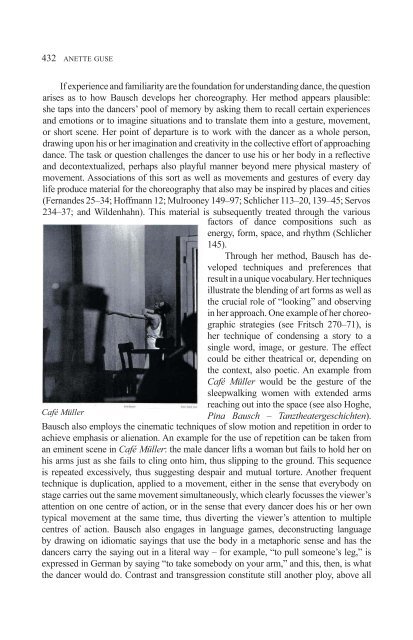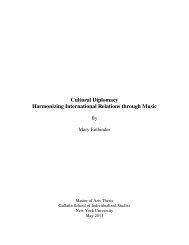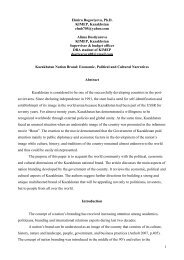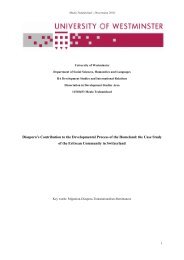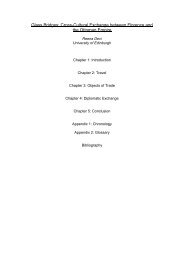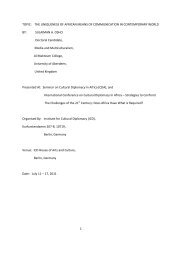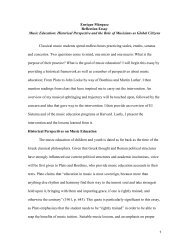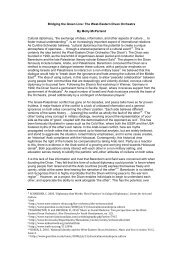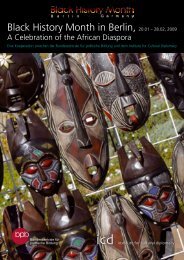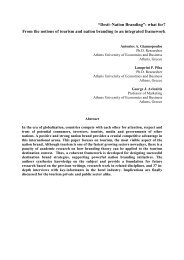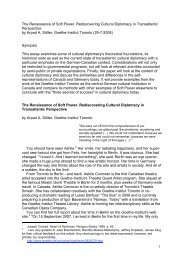Hable con ella - Institute for Cultural Diplomacy
Hable con ella - Institute for Cultural Diplomacy
Hable con ella - Institute for Cultural Diplomacy
You also want an ePaper? Increase the reach of your titles
YUMPU automatically turns print PDFs into web optimized ePapers that Google loves.
432 ANETTE GUSE<br />
If experience and familiarity are the foundation <strong>for</strong> understanding dance, the question<br />
arises as to how Bausch develops her choreography. Her method appears plausible:<br />
she taps into the dancers’ pool of memory by asking them to recall certain experiences<br />
and emotions or to imagine situations and to translate them into a gesture, movement,<br />
or short scene. Her point of departure is to work with the dancer as a whole person,<br />
drawing upon his or her imagination and creativity in the collective ef<strong>for</strong>t of approaching<br />
dance. The task or question challenges the dancer to use his or her body in a reflective<br />
and de<strong>con</strong>textualized, perhaps also playful manner beyond mere physical mastery of<br />
movement. Associations of this sort as well as movements and gestures of every day<br />
life produce material <strong>for</strong> the choreography that also may be inspired by places and cities<br />
(Fernandes 25–34; Hoffmann 12; Mulrooney 149–97; Schlicher 113–20, 139–45; Servos<br />
234–37; and Wildenhahn). This material is subsequently treated through the various<br />
factors of dance compositions such as<br />
energy, <strong>for</strong>m, space, and rhythm (Schlicher<br />
145).<br />
Through her method, Bausch has developed<br />
techniques and preferences that<br />
result in a unique vocabulary. Her techniques<br />
illustrate the blending of art <strong>for</strong>ms as well as<br />
the crucial role of “looking” and observing<br />
in her approach. One example of her choreographic<br />
strategies (see Fritsch 270–71), is<br />
her technique of <strong>con</strong>densing a story to a<br />
single word, image, or gesture. The effect<br />
could be either theatrical or, depending on<br />
the <strong>con</strong>text, also poetic. An example from<br />
Café Müller would be the gesture of the<br />
sleepwalking women with extended arms<br />
Café Müller<br />
reaching out into the space (see also Hoghe,<br />
Pina Bausch – Tanztheatergeschichten).<br />
Bausch also employs the cinematic techniques of slow motion and repetition in order to<br />
achieve emphasis or alienation. An example <strong>for</strong> the use of repetition can be taken from<br />
an eminent scene in Café Müller: the male dancer lifts a woman but fails to hold her on<br />
his arms just as she fails to cling onto him, thus slipping to the ground. This sequence<br />
is repeated excessively, thus suggesting despair and mutual torture. Another frequent<br />
technique is duplication, applied to a movement, either in the sense that everybody on<br />
stage carries out the same movement simultaneously, which clearly focusses the viewer’s<br />
attention on one centre of action, or in the sense that every dancer does his or her own<br />
typical movement at the same time, thus diverting the viewer’s attention to multiple<br />
centres of action. Bausch also engages in language games, de<strong>con</strong>structing language<br />
by drawing on idiomatic sayings that use the body in a metaphoric sense and has the<br />
dancers carry the saying out in a literal way – <strong>for</strong> example, “to pull someone’s leg,” is<br />
expressed in German by saying “to take somebody on your arm,” and this, then, is what<br />
the dancer would do. Contrast and transgression <strong>con</strong>stitute still another ploy, above all


